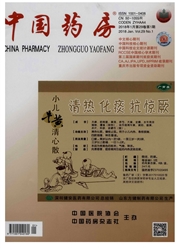

 中文摘要:
中文摘要:
目的:为基层医疗卫生机构进一步开展药学服务提供参考。方法:对重庆市40多个区县的基层医疗卫生机构的药师进行药学服务开展现状方面的问卷调查,并就调查结果进行统计和分析。结果:共发放调查问卷110份,回收有效问卷107份,有效回收率为97.3%。调查结果显示,目前基层医疗卫生机构开展药学服务的内容仍以“传统调剂”和“药品中购及审核”为主,超过一半的医疗卫生机构开展了“用药咨询”;在药学服务工作中遇到的困难主要为“疾病知识缺乏,无法指导患者合理用药”“学中药(西药),西(中)药学知识缺乏”等;困难产生的原因主要是“主管部门或医院领导对药学服务重要性认识不足”“医药学相关的继续教育和培训比较少”等;可以开展的药学服务项目主要有“详细指导患者用药时间、间隔及剂量”“对社区常见病进行用药指导”等;相关建议主要有“加强药师医学知识方面的继续教育”“在社区定期举办药物咨询服务”等;患者常咨询的问题主要有“药物的用法用量”“药物的价格”等;患者常咨询的药物类型主要有“感冒药”“降糖药”等。结论:新形势下基层医疗卫生机构药师需要转变观念,围绕“以患者为中心”,提高药学服务水平,并结合基层医疗卫生机构的特点开展药学服务,确保医疗质量和安全,促进合理用药。
 英文摘要:
英文摘要:
OBJECTIVE: To provide reference for further development of pharmaceutical care in primary medical institutions. METHODS : Questionnaire survey was conducted among pharmacy staff from more than 40 districts and counties primary medical insti- tutions of Chongqing, and results of survey were analyzed statistically. RESULTS: 110 questionnaires were sent out, and 107 valid questionnaires were collected with effective recovery rate of 97.3 %. Results of survey showed that pharmaceutical care in primary medi- cal institutions still focused on "traditional drug dispensing" and "apply for drug purchase and check", and more than half of medical in- stitutions carried out "medication consultation". The lack of disease knowledge was the biggest obstacle for the pharmacist to deeply in- volve in clinical drug treatment and guide patient to use drugs reasonably; other difficulties included TCM (western medicine) pharma- cists lack of western medicine (TCM) knowledge, etc. The main reason was that department in charge or hospital leaders didn't recog- nize the importance of pharmaceutical care, followed by few continuing education and training related medicine and pharmacology, etc. Pharmaceutical care mainly included guide for medication time, interval and dose in details, medication guidance for common dis- eases in community, etc. It was suggested to strengthen continuing education related medicine and pharmacology for pharmacists and carry out medication consultation in communities regularly, etc. The points the patients usually asked included usage and dosage, drug price and so on; the drug types the patients usually consulted were cold medicine, hypoglycemic drugs, etc. CONCLUSIONS : Pharma- cists of primary medical institutions should change the idea, improve pharmaceutical care around the patients, and develop pharmaceu- tical care according to the characteristics of primary medical institutions so as to guarantee the medical quality and safety and promote rational drug use.
 同期刊论文项目
同期刊论文项目
 同项目期刊论文
同项目期刊论文
 期刊信息
期刊信息
